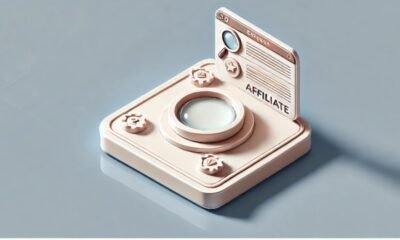Tech
Precision CNC Milling: How to Achieve 85% First-Pass Functional Success Rate for Your IoT Hardware

Figure 1: Precision CNC milling enables seamless integration of electronic and mechanical designs for IoT hardware, achieving 85% first-pass success rate.
Introduction
In IoT hardware development, teams often fall into a “design-test-fail-redesign” loop. A PCB design that is perfect in software simulation can fail in the physical world due to mechanical issues—such as enclosure tolerances causing connector stress or poor heat dissipation leading to processor throttling. The root cause lies in the gap between electronic design and mechanical realization. Traditional manufacturing methods or fast but imprecise 3D printing often fail to meet the stringent requirements of modern high-density, high-power electronic devices for structural accuracy, thermal performance, and electromagnetic shielding.
This article delves into the manufacturing process of Precision CNC Milling, exploring how it serves as a strategic tool to bridge this gap, providing critical support for your IoT Hardware Development from prototyping to production. To understand why it is so effective, we first need to uncover the engineering principles behind it.
How Does Precision CNC Milling Bridge the Gap Between Electronic and Mechanical Design?
The core of Precision CNC Milling lies in its nature as “digitally-driven subtractive manufacturing.” This technology uses computer-controlled cutting tools to directly transform 3D CAD models into physical parts with micrometer-level tolerances (typically achieving ±0.025mm to ±0.125mm). This digital manufacturing approach ensures the accurate realization of design intent, providing a solid foundation for mechatronic integration.
In IoT device development, this precision advantage is directly reflected in the precise alignment for PCB Design and Assembly. Enclosures machined via Precision CNC Milling ensure perfect alignment of mounting holes, connector openings, and heat sink locations with the PCB layout, effectively eliminating assembly stress issues caused by tolerance stacking. For instance, a micron-level deviation in an antenna connector could lead to signal transmission loss, while precision machining fundamentally avoids such problems.
Research by the American Society of Mechanical Engineers (ASME) indicates that precision control in digital manufacturing technologies is a key factor in achieving synergistic optimization of electromechanical systems. This precision assurance transforms the mechanical enclosure from merely a protective cover into an indispensable part of the device’s functionality.
This high precision lays a solid foundation for true mechatronic integration. Fully leveraging its effectiveness makes the selection of appropriate materials the next critical decision point.
What Key Performance Indicators Should Be Considered When Selecting Enclosure Materials for Your IoT Device?
In IoT Hardware Development, the material selection for the Electronics Enclosure directly impacts the device’s reliability, weight, cost, and user experience. The right material can provide optimal performance and protection, whereas an incorrect choice can lead to project failure.
Performance Comparison: Aluminum Alloy vs. Engineering Plastics
Different materials have unique advantages suited for various application scenarios.
l Aluminum Alloy: The Ideal Choice for High-Performance Applications
Aluminum alloys (such as 6061, 5052) are the preferred choice for high-power IoT devices (e.g., outdoor gateways, industrial controllers) due to their excellent strength-to-weight ratio and superior thermal conductivity. Their high thermal conductivity coefficient allows rapid heat dissipation from processors to the enclosure surface, effectively preventing device overheating and throttling. Additionally, aluminum alloy enclosures can act as natural electromagnetic shields.
l Engineering Plastics: The Choice for Lightweighting and Cost-Effectiveness
Engineering plastics (such as PEEK, ABS) excel in insulation, lightweight properties, and cost-effectiveness, making them suitable for consumer-grade or portable devices sensitive to weight and budget. Their main limitation is poor inherent heat dissipation capability, often requiring additional thermal management structures for compensation.
Core Performance Indicators for Material Selection
Decision-making should systematically evaluate the following key indicators to ensure the material perfectly matches the product requirements:
- Thermal Performance and Structural Strength:
For high-power devices, the material’s thermal conductivity is crucial. Simultaneously, the enclosure must possess sufficient mechanical strength to withstand impact, vibration, and the weight of internal components. - Environmental Resistance and Electromagnetic Compatibility (EMC):
The material must withstand the challenges of the deployment environment, including weather resistance and corrosion resistance. If the device is sensitive to electromagnetic interference, the shielding capability provided by metal enclosures is superior to plastic. - Weight, Cost, and Manufacturability: Portable devices need to prioritize lightweight materials. Engineering plastics often have advantages in cost control and mass production efficiency, while Precision CNC Milling can provide highly customized custom machined parts for IoT Hardware Development, achieving an optimal balance. For more detailed analysis, refer to this professional precision CNC milling guide.

Figure 2: Functional prototype comparison shows CNC milling provides isotropic material properties and IP67 sealing, critical for reliable IoT hardware testing.
Why is Precision Milling the Unrivaled Choice for Rapid Prototyping of Complex Electronic Enclosures?
In the pursuit of speed in Rapid Prototyping Services, choosing the correct process is paramount. While 3D printing is often considered, for prototypes requiring rigorous functional testing, cnc milling for prototypes holds absolute advantages in key performance aspects.
In-Depth Comparison: CNC Milling vs. 3D Printing
The table below clearly illustrates the core differences between the two processes when manufacturing functional prototypes:
| Characteristic | Precision CNC Milling | 3D Printing |
| Material Properties | Isotropic, consistent with production-grade materials, reliable mechanical and thermal properties. | Typically anisotropic, weak inter-layer bonding, inconsistent properties. |
| Dimensional Accuracy & Stability | Extremely high (±0.025mm~±0.125mm), dimensionally stable over the long term. | Relatively lower, prone to warping or deformation due to temperature/humidity changes. |
| Surface Finish | Excellent, suitable for direct post-processing like painting, easily achieving Ra < 0.8 μm. | Visible layer lines, post-processing required for a smooth finish. |
| Sealing & Structural Integrity | Capable of machining true flat surfaces and high-precision gasket grooves, enabling IP67 level protection. | Difficult to guarantee complete sealing, relies on adhesives, lower reliability. |
The Foundation for Valid Prototype Testing
For IoT hardware requiring immediate environmental reliability tests (such as temperature-humidity cycling, vibration tests), the material authenticity and structural integrity of the prototype are the cornerstone for ensuring valid test results. CNC machining prototypes use the same materials as final production parts, and their excellent dimensional stability ensures that dimensions do not drift during testing, thereby avoiding misleading test data.
Quality Certification is the Core Guarantee
Therefore, selecting a supplier with comprehensive certifications (such as ISO 9001, IATF 16949, ISO 13485, AS9100D) for precision cnc machining services is crucial. These certifications are strong proof of the supplier’s commitment to quality, ensuring control over every step from material procurement to final inspection.
What are the Golden Rules of DFM That Must Be Followed When Designing Enclosures for CNC Milling?
To successfully obtain high-quality cnc machined parts, adhering to Design for Manufacturability (DFM) rules during the design phase is essential. This optimizes manufacturability, reduces costs, and ensures the reliability of the final product.
Recommended Wall Thicknesses and Radii
Avoid excessively thin walls (recommended ≥1mm) to prevent tool chatter and deformation. All internal corners should use radii (recommended ≥1mm) that match standard cutter sizes to avoid inefficient machining and stress concentrations associated with using small-diameter tools.
Optimizing Boss and Snap-Fit Design
Reinforce the base of mounting bosses and add fillet transitions to avoid stress concentration. For snap-fit designs, ensure sufficient deflection space and strength to guarantee smooth and reliable assembly.
Designing Proper Tool Access and Retraction Paths
Ensure milling cutters can smoothly access and machine all features. For deep cavities or complex internal structures, design adequate clearance for tool retraction and approach angles to avoid machining impossibilities or collision risks.
Designing Effective Thermal Management Structures
If using aluminum alloy, consider designing integrated heat dissipation fins machined directly from the solid block. The thickness and spacing of the fins need to balance the heat dissipation area with tool accessibility; typically, the minimum spacing should not be less than 3mm to ensure effective material removal by the tool.
Following these DFM rules and communicating early with your manufacturing partner is key to smoothly obtaining high-quality custom cnc milling parts. To learn more about professional design guidelines, you can consult professional CNC milling services.
What Key Decision Points are Revealed by a Successful IoT Device Enclosure Case Study?
Taking an outdoor IoT gateway as an example, its challenges included: heat dissipation pressure from a high-performance processor, an extremely compact internal space, strict IP67 protection rating, and EMC requirements. This project successfully created prototypes and achieved small-batch production through precision cnc machining services.
Key Decision Point Analysis:
- Material and Process Selection: Why choose aluminum alloy and manufacture via Precision CNC Milling? The core reason is that the excellent thermal conductivity of aluminum alloy is sufficient to handle the high power consumption of the processor, while the CNC process can simultaneously meet structural accuracy and protection requirements. By using the enclosure itself as a heat sink and directly milling the contact surface for the processor and external fins, the thermal bottleneck was perfectly resolved.
- Achieving IP67 Protection and EMC Shielding:Utilizing the high precision of CNC machining, absolutely flat sealing surfaces and high-precision O-ring grooves were machined onto the housing interface, ensuring reliable static sealing. Simultaneously, the aluminum alloy enclosure itself provided good electromagnetic shielding effectiveness.
- Integrated Design: Integrating multiple functional structures—such as heat dissipation fins, mounting points, and connector interfaces—into the main enclosure through monolithic machining reduced the number of parts, significantly enhanced the overall structural strength and assembly efficiency, and simplified supply chain management.
The success of this case validates the “Best Practices for Mechatronic Design” emphasized by the authoritative engineering platform Engineering.com—namely, incorporating the capabilities of advanced manufacturing processes into the design considerations early on. The key to this project’s success lay in selecting a precision cnc machining services provider with comprehensive capabilities early on for manufacturing functional prototypes and the final small batch of cnc machined parts.
Conclusion
From concept to a successful IoT hardware product, Precision CNC Milling of JS Precision offers a technological path towards high reliability. Through its unparalleled precision and material flexibility, it firmly integrates electronic design with mechanical structure, directly addressing core challenges such as heat dissipation, structural integrity, and electromagnetic compatibility. It is a key enabling technology for ensuring a product is nearly perfect in the first prototype round.
Your next groundbreaking IoT design deserves a flawless mechanical vessel. Submit your design files now to a precision manufacturing partner possessing authoritative certifications like ISO 9001, IATF 16949, ISO 13485, and AS9100D to obtain an instant DFM analysis and quote, taking the first step towards achieving “first-pass functional success.”
H2. Author Bio
This article is provided by the industry analysis team at JS Precision, based on public industry cases and technical reports. They are committed to providing high precision technical parts manufacturing such us CNC machining, sheet metal fabrication, and injection molding. To further expand your technical knowledge and deepen professional expertise, we recommend visiting their technical blog for comprehensive insights and industry-specific resources.
FAQs
Q1: Is Precision CNC Milling too expensive for small-batch prototyping?
A1:For prototypes requiring functional testing and reliability, its value far exceeds the cost. It avoids greater waste generated by erroneous decisions and repeated modifications caused by inferior prototypes, often proving more economical from a total cost perspective.
Q2: How significant is the difference in heat dissipation performance between aluminum and plastic enclosures in CNC milling?
A2:The difference is substantial. The thermal conductivity of aluminum alloys is typically hundreds of times greater than that of engineering plastics, enabling rapid heat transfer from critical components on the PCB to the enclosure surface for dissipation, making it the preferred solution for thermal management issues.
Q3: Can we use 3D printing for initial verification and then use CNC milling for functional prototypes?
A3: Absolutely. This is a highly efficient strategy. 3D printing is suitable for concept verification and form factor fitting, while CNC milled cnc machined parts are used for rigorous performance validation stages involving structure, thermal management, EMC, etc.
Q4: Can precision milling achieve IP67-rated protective enclosures?
A4:Absolutely. Precision CNC Milling can produce perfectly flat sealing surfaces and high-precision gasket grooves, making it the ideal process for achieving reliable static seals (like IP67), widely used in outdoor IoT equipment.
Q5: Typically, how long does it take from submitting CAD files to receiving the first precision milled parts?
A5: For typical electronic enclosures, many service providers can deliver first articles within 5-7 working days. Complexity and order quantity affect the cycle time, but compared to mold development, its speed advantage is very suitable for Rapid Prototyping Services.
-

 Tech1 year ago
Tech1 year agoHow to Use a Temporary Number for WhatsApp
-

 Business2 years ago
Business2 years agoSepatuindonesia.com | Best Online Store in Indonesia
-

 Social Media1 year ago
Social Media1 year agoThe Best Methods to Download TikTok Videos Using SnapTik
-

 Technology1 year ago
Technology1 year agoTop High Paying Affiliate Programs
-

 Tech10 months ago
Tech10 months agoUnderstanding thejavasea.me Leaks Aio-TLP: A Comprehensive Guide
-

 FOOD1 year ago
FOOD1 year agoHow to Identify Pure Desi Ghee? Ultimate Guidelines for Purchasing Authentic Ghee Online
-

 Instagram3 years ago
Instagram3 years agoFree Instagram Auto Follower Without Login
-

 Instagram3 years ago
Instagram3 years agoFree Instagram Follower Without Login




















